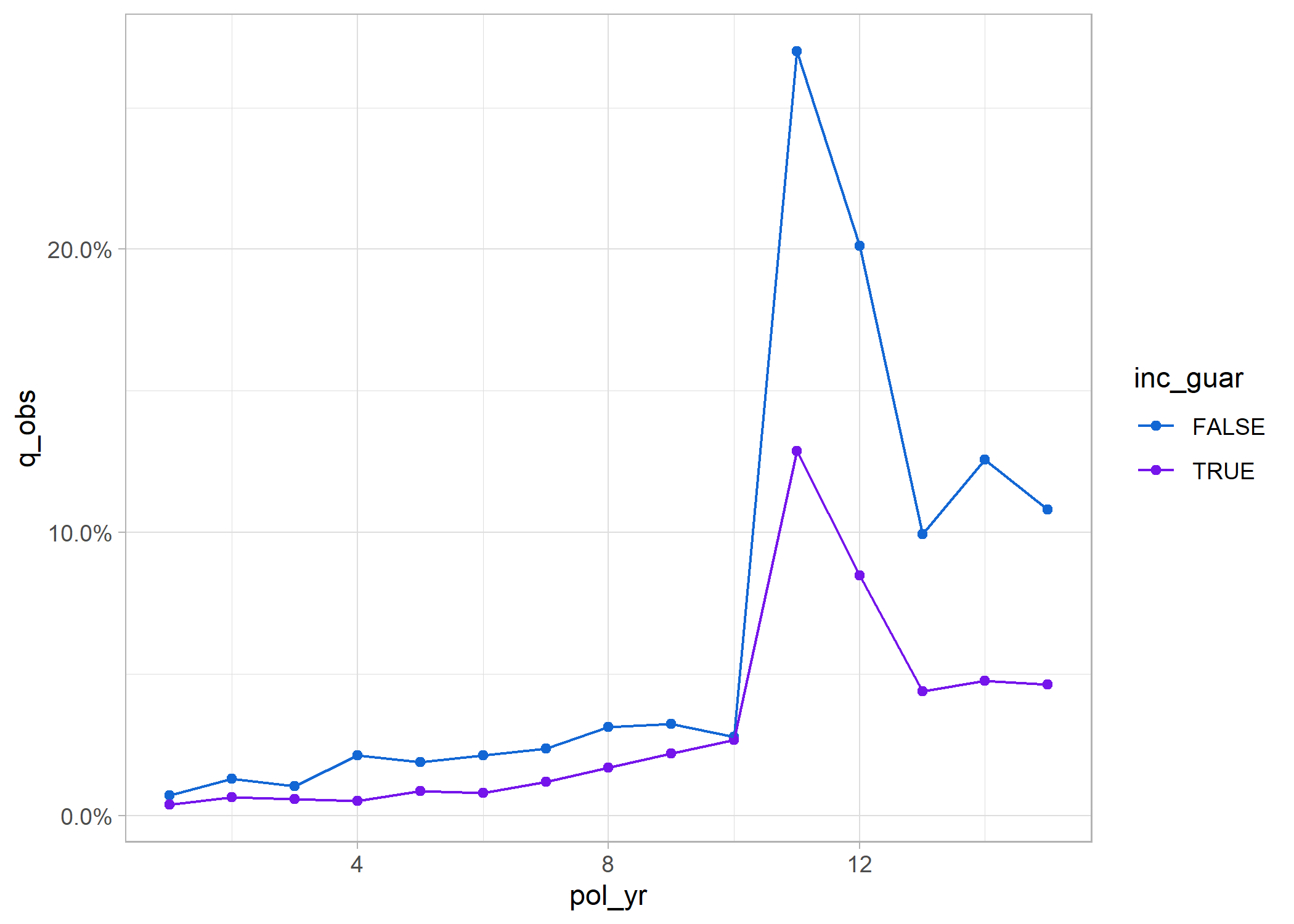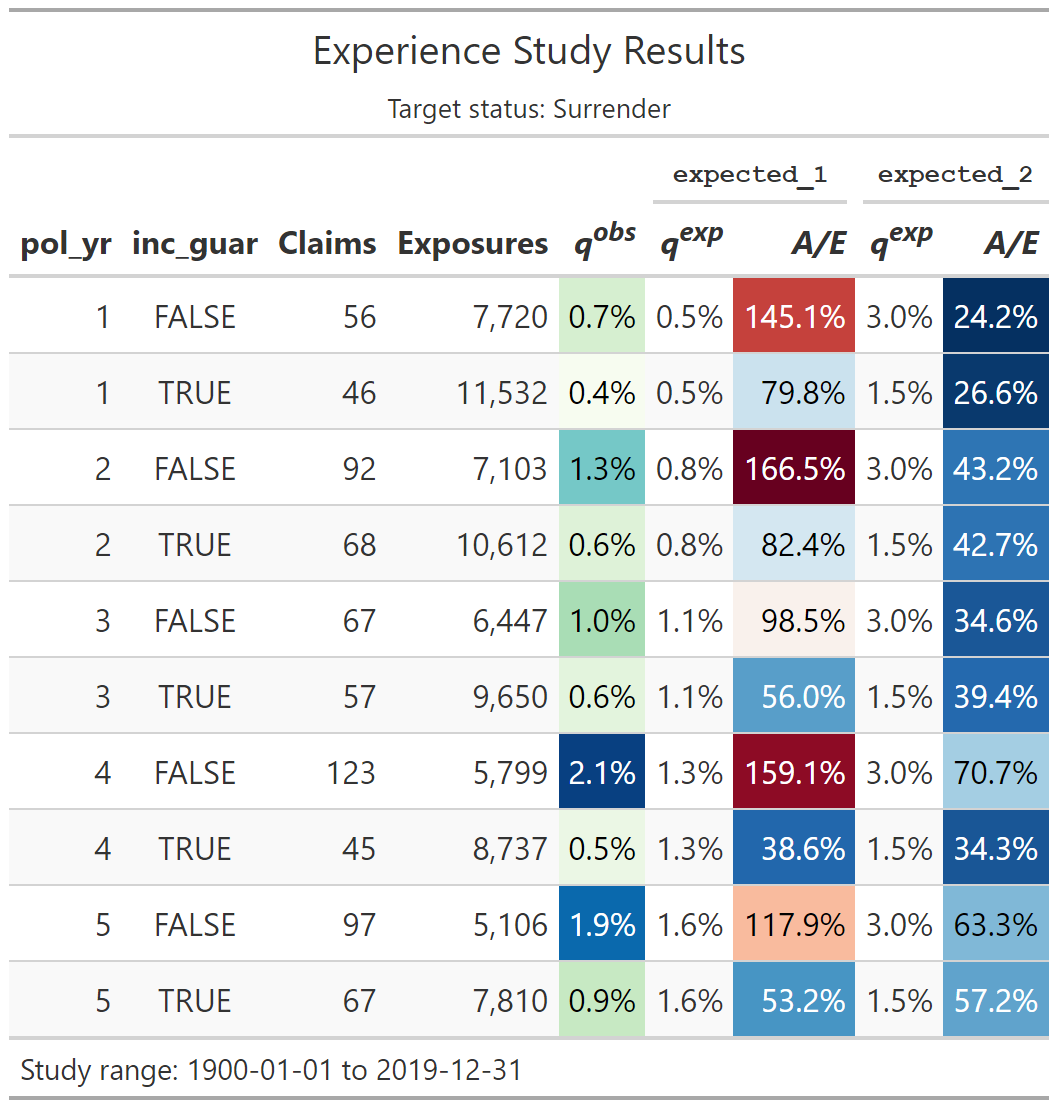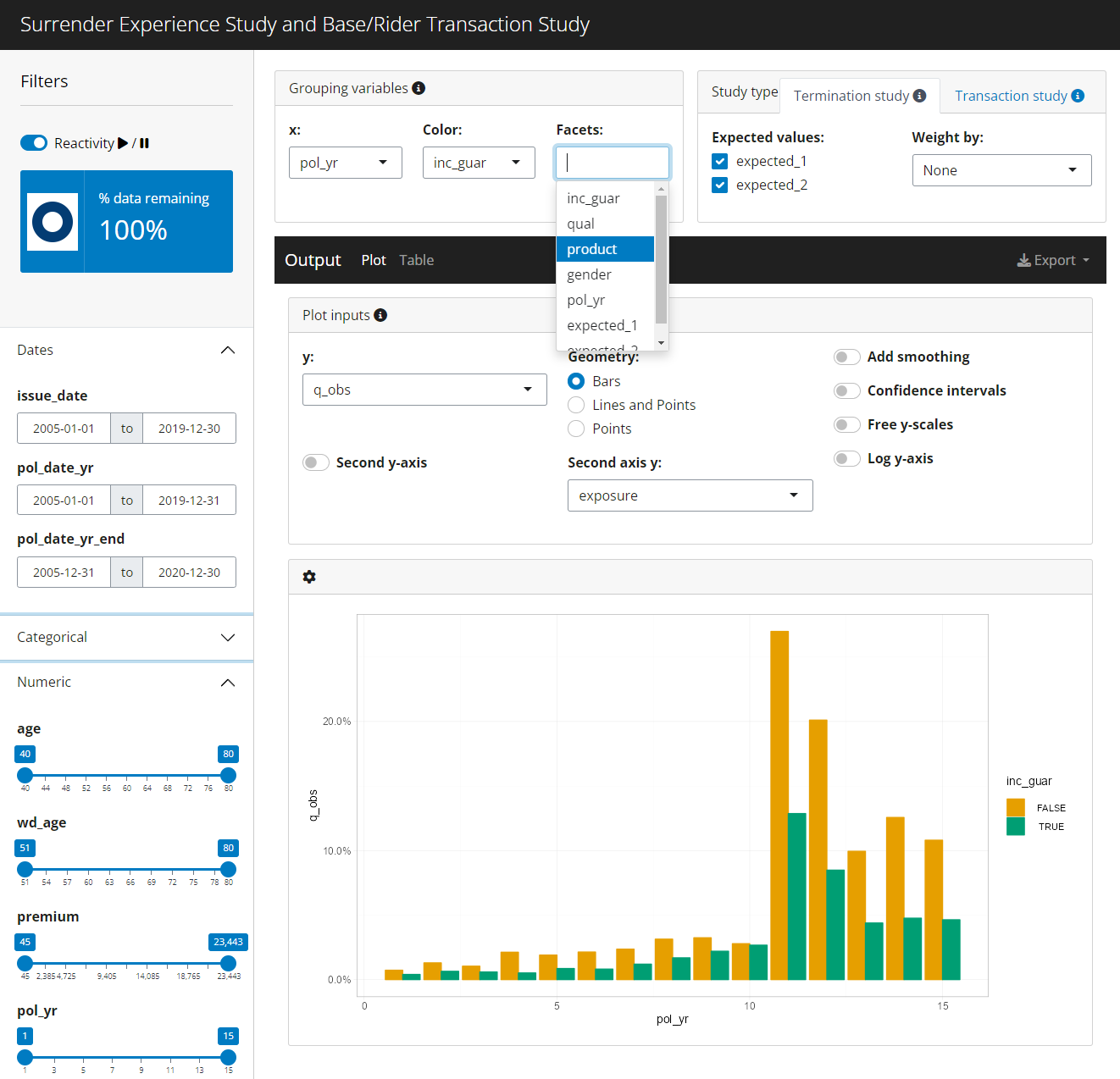
The hardware and bandwidth for this mirror is donated by METANET, the Webhosting and Full Service-Cloud Provider.
If you wish to report a bug, or if you are interested in having us mirror your free-software or open-source project, please feel free to contact us at mirror[@]metanet.ch.

The actxps package provides a set of tools to assist with the creation of actuarial experience studies. Experience studies are used by actuaries to explore historical experience across blocks of business and to inform assumption setting for projection models.
expose() family of functions convert census-level
records into policy or calendar year exposure records.exp_stats() function creates experience summary
data frames containing observed termination rates and claims.
Optionally, expected termination rates, actual-to-expected ratios, and
limited fluctuation credibility estimates can also be returned.add_transactions() function attaches summarized
transactions to a data frame with exposure-level records.trx_stats() function creates transaction summary
data frames containing transaction counts, amounts, frequencies, and
utilization. Optionally, transaction amounts can be expressed as a
percentage of one or more variables to calculate rates or
actual-to-expected ratios.autoplot() and autotable() functions
creates plots and tables for reporting.exp_shiny() function launches a Shiny app that
allows for interactive exploration of experience drivers.The actxps package can be installed from CRAN with:
install.packages("actxps")To install the development version from GitHub use:
devtools::install_github("mattheaphy/actxps")An expanded version of this demo is available in
vignette("actxps").
The actxps package includes simulated census data for a theoretical deferred annuity product with an optional guaranteed income rider. The grain of this data is one row per policy.
library(actxps)
library(dplyr)
census_dat
#> # A tibble: 20,000 × 11
#> pol_num status issue_date inc_guar qual age product gender wd_age premium
#> <int> <fct> <date> <lgl> <lgl> <int> <fct> <fct> <int> <dbl>
#> 1 1 Active 2014-12-17 TRUE FALSE 56 b F 77 370
#> 2 2 Surren… 2007-09-24 FALSE FALSE 71 a F 71 708
#> 3 3 Active 2012-10-06 FALSE TRUE 62 b F 63 466
#> 4 4 Surren… 2005-06-27 TRUE TRUE 62 c M 62 485
#> 5 5 Active 2019-11-22 FALSE FALSE 62 c F 67 978
#> 6 6 Active 2018-09-01 FALSE TRUE 77 a F 77 1288
#> 7 7 Active 2011-07-23 TRUE TRUE 63 a M 65 1046
#> 8 8 Active 2005-11-08 TRUE TRUE 58 a M 58 1956
#> 9 9 Active 2010-09-19 FALSE FALSE 53 c M 64 2165
#> 10 10 Active 2012-05-25 TRUE FALSE 61 b M 73 609
#> # ℹ 19,990 more rows
#> # ℹ 1 more variable: term_date <date>Convert census records to exposure records with one row per policy per year.
exposed_data <- expose(census_dat, end_date = "2019-12-31",
target_status = "Surrender")
exposed_data
#>
#> ── Exposure data ──
#>
#> • Exposure type: policy_year
#> • Target status: Surrender
#> • Study range: 1900-01-01 to 2019-12-31
#>
#> # A tibble: 141,252 × 15
#> pol_num status issue_date inc_guar qual age product gender wd_age premium
#> <int> <fct> <date> <lgl> <lgl> <int> <fct> <fct> <int> <dbl>
#> 1 1 Active 2014-12-17 TRUE FALSE 56 b F 77 370
#> 2 1 Active 2014-12-17 TRUE FALSE 56 b F 77 370
#> 3 1 Active 2014-12-17 TRUE FALSE 56 b F 77 370
#> 4 1 Active 2014-12-17 TRUE FALSE 56 b F 77 370
#> 5 1 Active 2014-12-17 TRUE FALSE 56 b F 77 370
#> 6 1 Active 2014-12-17 TRUE FALSE 56 b F 77 370
#> 7 2 Active 2007-09-24 FALSE FALSE 71 a F 71 708
#> 8 2 Active 2007-09-24 FALSE FALSE 71 a F 71 708
#> 9 2 Active 2007-09-24 FALSE FALSE 71 a F 71 708
#> 10 2 Active 2007-09-24 FALSE FALSE 71 a F 71 708
#> # ℹ 141,242 more rows
#> # ℹ 5 more variables: term_date <date>, pol_yr <int>, pol_date_yr <date>,
#> # pol_date_yr_end <date>, exposure <dbl>Create a summary grouped by policy year and the presence of a guaranteed income rider.
exp_res <- exposed_data |>
group_by(pol_yr, inc_guar) |>
exp_stats()
exp_res
#>
#> ── Experience study results ──
#>
#> • Groups: pol_yr and inc_guar
#> • Target status: Surrender
#> • Study range: 1900-01-01 to 2019-12-31
#>
#> # A tibble: 30 × 6
#> pol_yr inc_guar n_claims claims exposure q_obs
#> <int> <lgl> <int> <int> <dbl> <dbl>
#> 1 1 FALSE 56 56 7720. 0.00725
#> 2 1 TRUE 46 46 11532. 0.00399
#> 3 2 FALSE 92 92 7103. 0.0130
#> 4 2 TRUE 68 68 10612. 0.00641
#> 5 3 FALSE 67 67 6447. 0.0104
#> 6 3 TRUE 57 57 9650. 0.00591
#> 7 4 FALSE 123 123 5799. 0.0212
#> 8 4 TRUE 45 45 8737. 0.00515
#> 9 5 FALSE 97 97 5106. 0.0190
#> 10 5 TRUE 67 67 7810. 0.00858
#> # ℹ 20 more rowsCalculate actual-to-expected ratios.
First, attach one or more columns of expected termination rates to
the exposure data. Then, pass these column names to the
expected argument of exp_stats().
expected_table <- c(seq(0.005, 0.03, length.out = 10), 0.2, 0.15, rep(0.05, 3))
# using 2 different expected termination rates
exposed_data <- exposed_data |>
mutate(expected_1 = expected_table[pol_yr],
expected_2 = ifelse(exposed_data$inc_guar, 0.015, 0.03))
exp_res <- exposed_data |>
group_by(pol_yr, inc_guar) |>
exp_stats(expected = c("expected_1", "expected_2"))
exp_res
#>
#> ── Experience study results ──
#>
#> • Groups: pol_yr and inc_guar
#> • Target status: Surrender
#> • Study range: 1900-01-01 to 2019-12-31
#> • Expected values: expected_1 and expected_2
#>
#> # A tibble: 30 × 10
#> pol_yr inc_guar n_claims claims exposure q_obs expected_1 expected_2
#> <int> <lgl> <int> <int> <dbl> <dbl> <dbl> <dbl>
#> 1 1 FALSE 56 56 7720. 0.00725 0.005 0.03
#> 2 1 TRUE 46 46 11532. 0.00399 0.005 0.015
#> 3 2 FALSE 92 92 7103. 0.0130 0.00778 0.03
#> 4 2 TRUE 68 68 10612. 0.00641 0.00778 0.015
#> 5 3 FALSE 67 67 6447. 0.0104 0.0106 0.03
#> 6 3 TRUE 57 57 9650. 0.00591 0.0106 0.015
#> 7 4 FALSE 123 123 5799. 0.0212 0.0133 0.03
#> 8 4 TRUE 45 45 8737. 0.00515 0.0133 0.015
#> 9 5 FALSE 97 97 5106. 0.0190 0.0161 0.03
#> 10 5 TRUE 67 67 7810. 0.00858 0.0161 0.015
#> # ℹ 20 more rows
#> # ℹ 2 more variables: ae_expected_1 <dbl>, ae_expected_2 <dbl>Create visualizations using the autoplot() and
autotable() functions.
autoplot(exp_res)
# first 10 rows showed for brevity
exp_res |> head(10) |> autotable()
Launch a Shiny app to interactively explore experience data.
exp_shiny(exposed_data)
Logo
Image by macrovector on Freepik
These binaries (installable software) and packages are in development.
They may not be fully stable and should be used with caution. We make no claims about them.